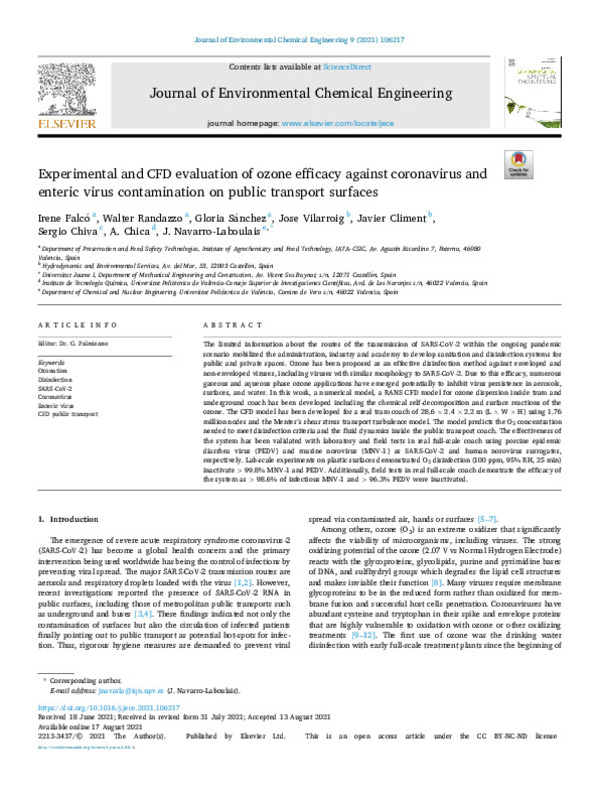JavaScript is disabled for your browser. Some features of this site may not work without it.
Buscar en RiuNet
Listar
Mi cuenta
Estadísticas
Ayuda RiuNet
Admin. UPV
Experimental and CFD evaluation of ozone efficacy against coronavirus and enteric virus contamination on public transport surfaces
Mostrar el registro sencillo del ítem
Ficheros en el ítem
| dc.contributor.author | Falcó, Irene
|
es_ES |
| dc.contributor.author | Randazzo, Walter
|
es_ES |
| dc.contributor.author | Sánchez, Gloria
|
es_ES |
| dc.contributor.author | Vilarroig, José
|
es_ES |
| dc.contributor.author | Climent, Javier
|
es_ES |
| dc.contributor.author | Chiva, Sergio
|
es_ES |
| dc.contributor.author | Chica, Antonio
|
es_ES |
| dc.contributor.author | Navarro-Laboulais, J.
|
es_ES |
| dc.date.accessioned | 2022-10-18T18:03:25Z | |
| dc.date.available | 2022-10-18T18:03:25Z | |
| dc.date.issued | 2021-10 | es_ES |
| dc.identifier.uri | http://hdl.handle.net/10251/188188 | |
| dc.description.abstract | [EN] The limited information about the routes of the transmission of SARS-CoV-2 within the ongoing pandemic scenario mobilized the administration, industry and academy to develop sanitation and disinfection systems for public and private spaces. Ozone has been proposed as an effective disinfection method against enveloped and non-enveloped viruses, including viruses with similar morphology to SARS-CoV-2. Due to this efficacy, numerous gaseous and aqueous phase ozone applications have emerged potentially to inhibit virus persistence in aerosols, surfaces, and water. In this work, a numerical model, a RANS CFD model for ozone dispersion inside tram and underground coach has been developed including the chemical self-decomposition and surface reactions of the ozone. The CFD model has been developed for a real tram coach of 28.6 x 2.4 x 2.2 m (L x W x H) using 1.76 million nodes and the Menter's shear stress transport turbulence model. The model predicts the O-3 concentration needed to meet disinfection criteria and the fluid dynamics inside the public transport coach. The effectiveness of the system has been validated with laboratory and field tests in real full-scale coach using porcine epidemic diarrhea virus (PEDV) and murine norovirus (MNV-1) as SARS-CoV-2 and human norovirus surrogates, respectively. Lab-scale experiments on plastic surfaces demonstrated O3 disinfection (100 ppm, 95% RH, 25 min) inactivate > 99.8% MNV-1 and PEDV. Additionally, field tests in real full-scale coach demostrate the efficacy of the system as > 98.6% of infectious MNV-1 and > 96.3% PEDV were inactivated. | es_ES |
| dc.description.sponsorship | The authors thanks to the companies LIC - Levantina Ingenieria y Construccion S.L. (Spain) and Vareser (Spain) for funding this study. The authors also acknowledge FGV-Ferrocarriles de la Generalitat Valenciana to supply the tram coach to carry out the field experiments. Especial thanks to Jose Ruz and Jose Barbeta to supply us the field experimental data. | es_ES |
| dc.language | Inglés | es_ES |
| dc.publisher | Elsevier | es_ES |
| dc.relation.ispartof | Journal of Environmental Chemical Engineering | es_ES |
| dc.rights | Reconocimiento - No comercial - Sin obra derivada (by-nc-nd) | es_ES |
| dc.subject | Ozonation | es_ES |
| dc.subject | Disinfection | es_ES |
| dc.subject | SARS-CoV-2 | es_ES |
| dc.subject | Coronavirus | es_ES |
| dc.subject | Enteric virus | es_ES |
| dc.subject | CFD public transport | es_ES |
| dc.subject.classification | INGENIERIA QUIMICA | es_ES |
| dc.title | Experimental and CFD evaluation of ozone efficacy against coronavirus and enteric virus contamination on public transport surfaces | es_ES |
| dc.type | Artículo | es_ES |
| dc.identifier.doi | 10.1016/j.jece.2021.106217 | es_ES |
| dc.rights.accessRights | Abierto | es_ES |
| dc.contributor.affiliation | Universitat Politècnica de València. Instituto Universitario Mixto de Tecnología Química - Institut Universitari Mixt de Tecnologia Química | es_ES |
| dc.contributor.affiliation | Universitat Politècnica de València. Departamento de Ingeniería Química y Nuclear - Departament d'Enginyeria Química i Nuclear | es_ES |
| dc.description.bibliographicCitation | Falcó, I.; Randazzo, W.; Sánchez, G.; Vilarroig, J.; Climent, J.; Chiva, S.; Chica, A.... (2021). Experimental and CFD evaluation of ozone efficacy against coronavirus and enteric virus contamination on public transport surfaces. Journal of Environmental Chemical Engineering. 9(5). https://doi.org/10.1016/j.jece.2021.106217 | es_ES |
| dc.description.accrualMethod | S | es_ES |
| dc.relation.publisherversion | https://doi.org/10.1016/j.jece.2021.106217 | es_ES |
| dc.description.upvformatpinicio | 106217 | es_ES |
| dc.type.version | info:eu-repo/semantics/publishedVersion | es_ES |
| dc.description.volume | 9 | es_ES |
| dc.description.issue | 5 | es_ES |
| dc.identifier.eissn | 2213-3437 | es_ES |
| dc.identifier.pmid | 34422551 | es_ES |
| dc.identifier.pmcid | PMC8367738 | es_ES |
| dc.relation.pasarela | S\459319 | es_ES |
| dc.contributor.funder | Levantina, Ingeniería y Construcción, S.L. | es_ES |








